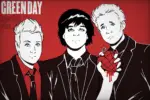In 2002, the pop-punk genre consumed the mainstream American music scene. Pop-punk queen Avril Lavigne released her debut album, “Let Go,” which spawned the classic singles “Complicated” and “Sk8er Boi.” Other popular acts at the time included Green Day, Blink-182, Good Charlotte and Paramore. Teenage angst took over airwaves, awards shows and pop culture. Twenty years later and this style of music is resurging. Some of the most popular up-and-coming artists, such as Pinkshift, WILLOW, Yungblud and Olivia Rodrigo, are either pop punk or incorporate elements of the genre in their music. Even Lavigne still crafts pop-punk songs with her seventh and latest album, “Love Sux,” which came out on Feb. 25.
The History of Pop Punk Music
The origins of the genre trace back to 1970s New York City and London. While the start of American pop punk comes from NYC, the London scene still heavily influenced global punk culture. In both cities, the punk movement arose in reaction to the media and state of the world at the time. In America, small venues hosted underground rock that was edgier than the bubblegum pop of the ‘60s. The Ramones in particular are considered to be the ones that cleared the way for future punk rock and eventually pop punk.
In London, in the midst of a stifling post-war consensus and later, Margaret Thatcher’s reign as prime minister, many young people felt frustrated with the state of the country and channeled their anger into songwriting and dressing unconventionally. From there, the subculture and its accompanying music continued to grow. 1994 marked the year pop punk broke into the mainstream, with the help of artists like Green Day, Bad Religion and newcomer The Offspring. The genre declined in the 2010s before being revived in the past few years.
Gen Z’s Adaptation of the Genre
Current pop punk, while obviously influenced by its predecessors from the early aughts, reflects Generation Z’s values. One of the apparent differences is the motivations behind the more pessimistic tunes. In the 2000s, American teens witnessed the 9/11 terrorist attacks and the subsequent controversial actions of former President Geroge W. Bush, who decided to go to war with Afghanistan and later, Iraq. At the time, mental health was not taken as seriously as it is today, but a multitude of songs discussed the struggles of depression and suicidal ideation in an unglamorized manner.
Fast forward two decades and modern teenagers, ones who are arguably more socially conscious than ever before, are reeling from the effects of Donald Trump’s presidency and a pandemic. Adolescents in the United States, similar to teens from years prior, are in a maddening state of limbo where they feel like their impact on the world is limited. Gen Z’s sense of self-awareness and pessimism pairs well with the genre.
Another distinction in the current pop-punk landscape is the increase in the number of diverse and inclusive acts. In the ‘00s, the major bands were mostly made up of white, cisgender, straight men. Of course, that still somewhat applies today, as the most commercially successful pop-punk star as of late is Machine Gun Kelly — his fifth studio album, released in September 2020, debuted at the top of the Billboard 200 chart and sold 126,000 units in its first week. However, people of color, as well as gender nonconforming, queer people and women are now fronting popular groups or gaining attention as solo acts.
WILLOW and Rodrigo are women of color. Yungblud openly identifies as pansexual and polyamorous. Pinkshift’s female lead singer, along with most of the band, is also a person of color. The same can be said for the band Meet Me @ The Altar, a three-person group made up of women of color. More work still needs to be done for these kinds of acts to receive the attention they deserve, but Gen Z’s pop punk is certainly taking a step in the right direction; while the 2000s scene also contained people from marginalized communities, they were much less represented in the media.
Another development within current pop punk is the use of social media. For example, TikTok has helped secure record deals for pop-punk singers. Cole “Lil Huddy” Hudson, Jaden “Jxdn” Hossler and Nessa Barrett are a few TikTokers-turned-pop-punk acts. Each of them release music in the genre and often work with Travis Barker, producer and drummer for Blink-182. Barker also collaborated with Kelly and Lavigne. The genre continues to expand and inspire musicians across social media.
Changes in Defining Music
While pop punk, like all kinds of music, used to be a well-defined genre, the boundaries between different styles of music have slowly disappeared. The shift can be attributed to the rise of streaming services that allow consumers to hear a wide range of music more easily, as well as better access to production technology for independent artists.
The blurring of genres has not only meant that pop punk now appears in pop and rock, but it also shows up in other supposedly separate music categories. For example, pop-punk rap, known as emo rap or SoundCloud rap, was a trend in the late 2010s, popularized by artists like XXXTentacion, Juice Wrld and Lil Peep. The genre has been visible in other hip-hop tracks as well. Pop punk’s regeneration is visible in more spaces than you might expect.
The Future of Pop Punk Music
Pop punk seems to be on an upward trajectory that does not appear to be stopping any time soon. More and more musical artists are taking influence from the genre and infusing those aspects into their own work. Also, the world is experiencing more and more global and national chaos with the invasion of Ukraine and the passage of dangerous laws directed against certain groups of oppressed people. There is a lot for teenagers to be enraged about. It will be interesting to see how pop punk will develop and impact pop culture at large from here on out.
















